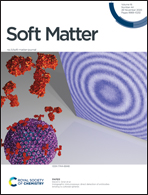Acid-responsive fibrillation and urease-assisted defibrillation of phenylalanine: a transient supramolecular hydrogel†
Abstract
The aggregation of proteins and peptides into fibrils is associated with many neurodegenerative diseases in humans, including Alzheimer's disease, Parkinson's disease and non-neurological type-II diabetes. A better understanding of the fibril formation process and defibrillation using biochemical tools is highly important for therapeutics. Under physiological conditions, acidic pH promotes the formation of toxic fibrils. Here, a mimic of living systems has been achieved by the acid-responsive assembly of benzyloxycarbonyl-L-phenylalanine to fibrils, as well as the urease-assisted disassembly of the said fibrils. The simultaneous incorporation of the two triggers helped to prepare a transient supramolecular hydrogel from benzyloxycarbonyl-L-phenylalanine-entangled fibrils with a high degree of control over the self-assembly lifetime and mechanical properties. Further, under acidic pH, the compound formed the O–H⋯O![[double bond, length as m-dash]](https://www.rsc.org/images/entities/char_e001.gif) C hydrogen-bonded dimer. The dimers were further self-assembled by intermolecular N–H⋯O
C hydrogen-bonded dimer. The dimers were further self-assembled by intermolecular N–H⋯O![[double bond, length as m-dash]](https://www.rsc.org/images/entities/char_e001.gif) C hydrogen bonds and π–π stacking interactions to form fibrils with high mechanical properties, from this simple molecule. However, the self-assembly process is dynamic. Hence, the in situ-generated NH3 uniformly increased the pH and led to the homogeneous disassembly of the fibrils. Thus, this report provides a valuable approach to defibrillation.
C hydrogen bonds and π–π stacking interactions to form fibrils with high mechanical properties, from this simple molecule. However, the self-assembly process is dynamic. Hence, the in situ-generated NH3 uniformly increased the pH and led to the homogeneous disassembly of the fibrils. Thus, this report provides a valuable approach to defibrillation.

- This article is part of the themed collections: #RSCPoster Conference and Peptide Soft Materials


 Please wait while we load your content...
Please wait while we load your content...